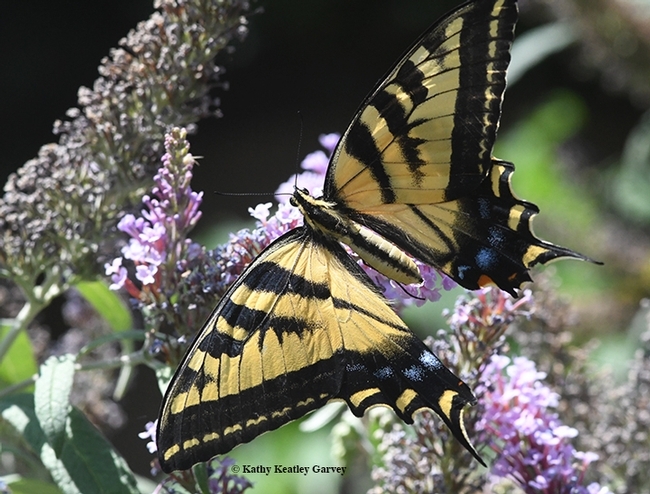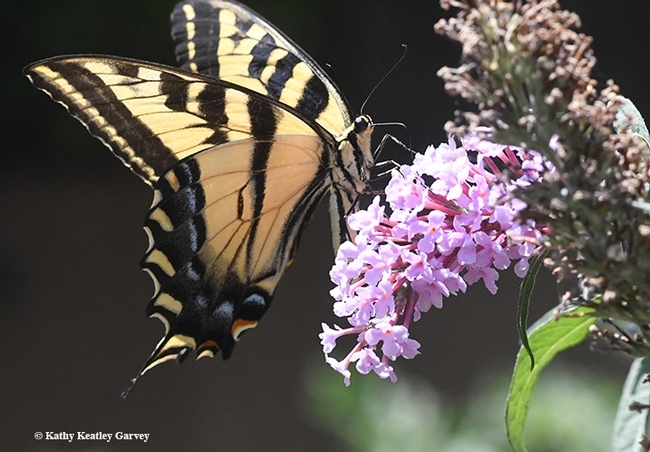- Author: Kathy Keatley Garvey
When a newly eclosed Western tiger swallowtail, Papilio rutulus, lands on a butterfly bush, the colors are striking.
The yellow and black butterfly contrasts well on the purple blossoms of Buddleja davidii.
While the majestic butterfly is widely loved, the plant, also called summer lilac, is not. It's considered an ecological threat and a noxious weed by the Invasive Plant Atlas of the United States: "Buddleja davidii readily invades disturbed sites and riparian areas. Although butterflies will use this plant as a nectar source their larvae cannot survive on it. By replacing native larval food source plants butterfly bush can have a negative impact on wildlife."
B. davidii is native to Sichuan and Hubei provinces in central China, and also Japan. The genus, Buddleja, is named for the Rev. Adam Buddle, an English botanist. The species name honors Father Armand David, a French missionary and explorer in China, Father Armand David, who was the first European to report the shrub, according to Wikipedia. It won the RHS Award of Merit in 1898, and the Award of Garden Merit (AGM) in 1941.
Now nurseries are selling non-invasive hybrids, with such names as "Lo and Behold" and "Blue Chip" and "Flutterby."
Nevertheless, who can resist photographing the Western tiger swallowtail as it stops to nectar on a butterfly bush?
Lo and behold...
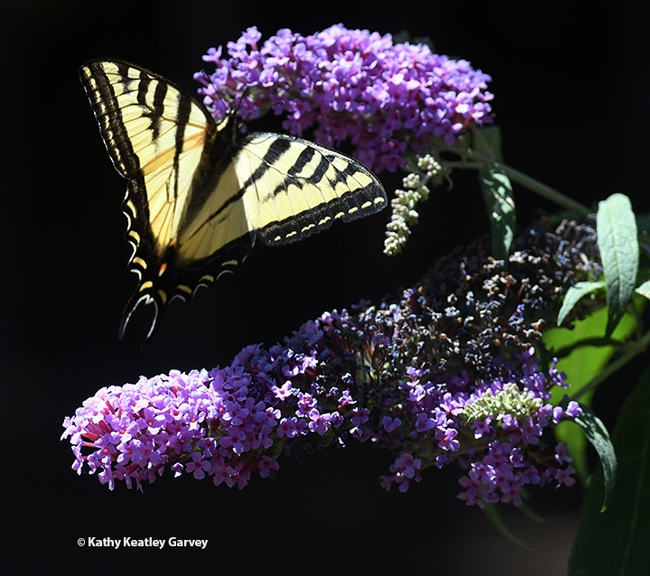
- Author: Kathy Keatley Garvey
Question: What's better than seeing a monarch butterfly?
Answer: Seeing two monarch butterflies sharing the same blossom on a butterfly bush!
Scenario: Monarchs (Danaus plexippus) from the Pacific Northwest are fluttering through Vacaville, Calif. and stopping in our pollinator garden for some flight fuel before heading off to their overwintering sites along coastal California.
Background: I am watching for tagged butterflies from the migratory monarch project of Washington State University entomologist David James. (After all, one tagged by his citizen scientist Steven Johnson of Ashland, Ore., on Aug. 28, 2016, fluttered into our yard seven days later. James said it flew 285 miles in 7 days or about 40.7 miles per day.)
Menu: In our pollinator garden, the flight fuel includes nectar from the Mexican sunflower (Tithonia rotundifola), tropical milkweed (Asclepias curassavica), butterfly bush (Buddleia davidii), and Zinnias, a genus of plants of the tribe Heliantheae within the family Asteraceae.
Action: On Sept. 27, a male monarch touches down on our butterfly bush and begins sipping nectar. Soon, another joins him.
The two monarchs engage in what appears to be a territorial battle. It's a kaleidoscope of orange and black wings, tumbling, wobbling, recovering.
And then, wings up! The monarchs take flight.
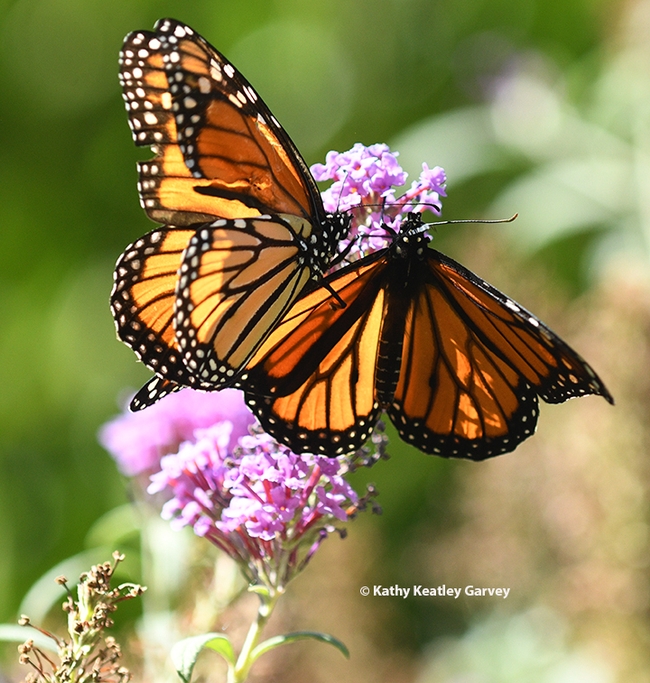
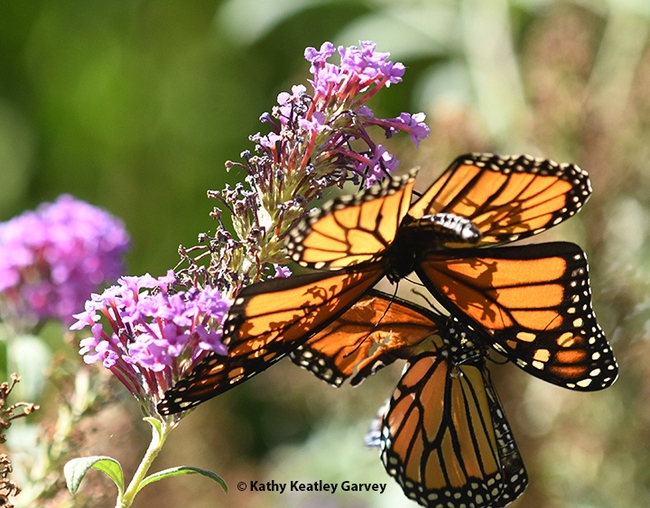
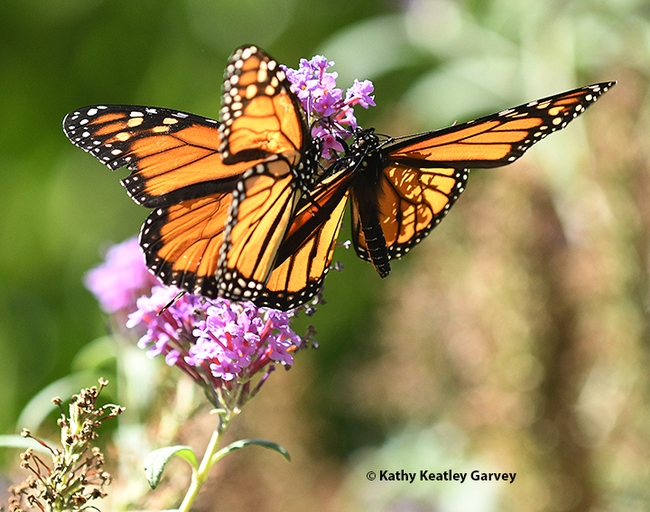
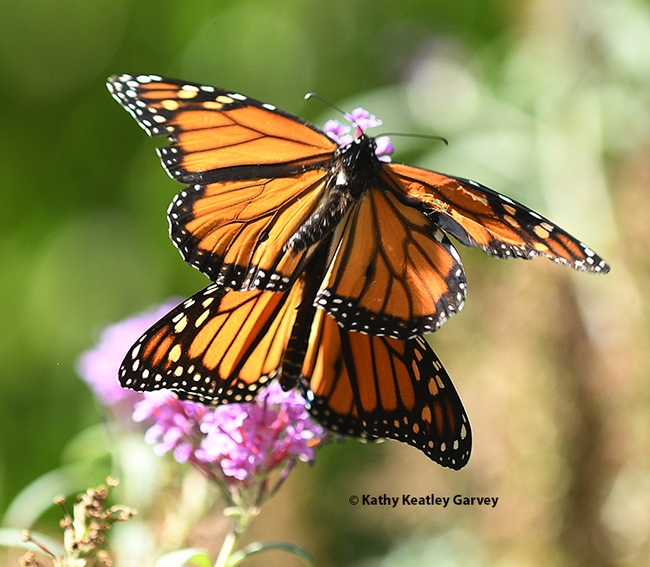
- Author: Kathy Keatley Garvey
Never be late for dinner or it might be all gone.
Take the case of the Mexican sunflowers, Tithonia rotundifola, that we planted last April for the monarchs. Monarchs seem to favor Tithonia more than any other nectar source in our pollinator garden. Second choice: the butterfly bush, Buddleia davidii.
May, June, July, and August came and went. The invited (and expected) guests were a "no show." Didn't they make reservations? Or did they forget?
The Tithonia drew honey bees, long-horned bees, syrphid flies, a praying mantis, and assorted butterflies. No monarchs.
In September, entomologist David James of Washington State University, who studies migratory monarchs, announced the monarchs are on their way from the Pacific Northwest to their overwintering sites along coastal California. "They're coming," he said.
Finally, on Sept. 16, a single monarch glided in, sipped some nectar on the Buddleia for a few seconds and left. Another monarch stopped by on Sept. 26, nectared on the Tithonia for a couple of seconds and vanished.
Where are all the dinner guests?
Finally, at 4:30 p.m. on Oct. 3, a male monarch arrived for dinner. And what a 12-course dinner it was on the Tithonia's remaining 12 flowers. He paused once to sample nectar from the Buddleia, but he obviously preferred the Tithonia.
Frankly, it's not been a good year for monarchs in our pollinator garden. Monarchs totally ignored the milkweed, their host plant, and almost disregarded the nectar sources. In comparison, back in 2016, monarchs laid about 300 eggs on our milkweed. In the migratory season, it was not uncommon to see seven monarchs in our garden at one time.
If any more monarchs arrive, they'll not get much Tithonia or Buddleia to fuel their flight to the overwintering sites. They'll have to settle for what's left of the nectar sources: African blue basil, catmint, lion's tail, Mexican petunia, and honeysuckle.
We're just glad one dinner guest showed up, although he was almost too late for dinner.
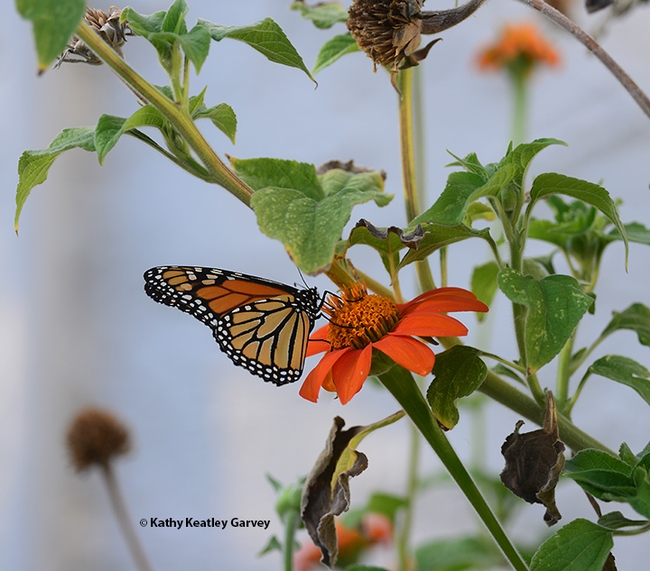
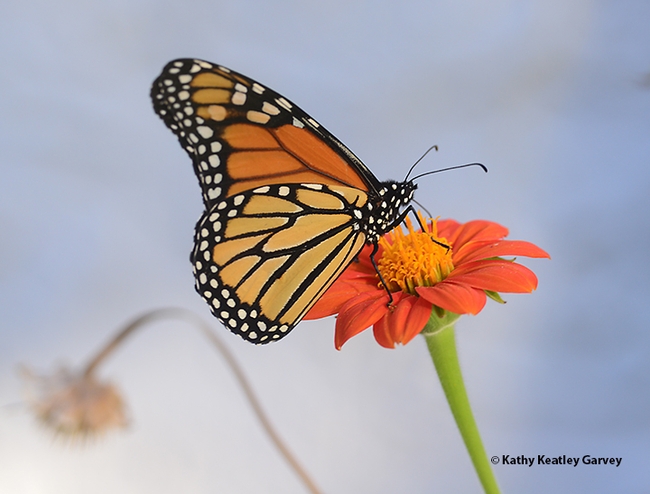
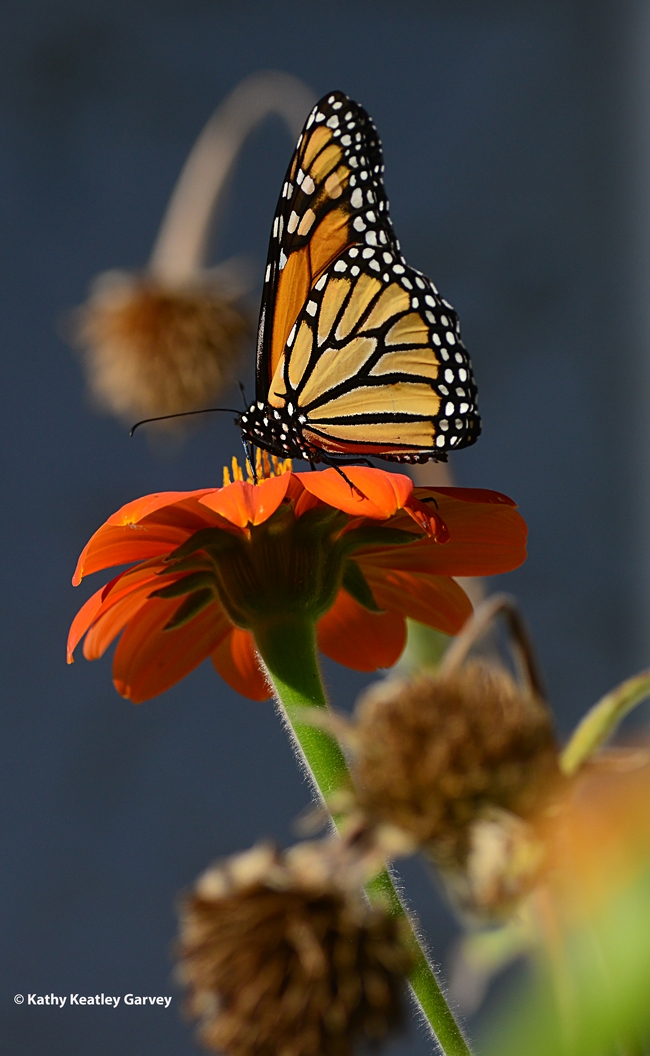
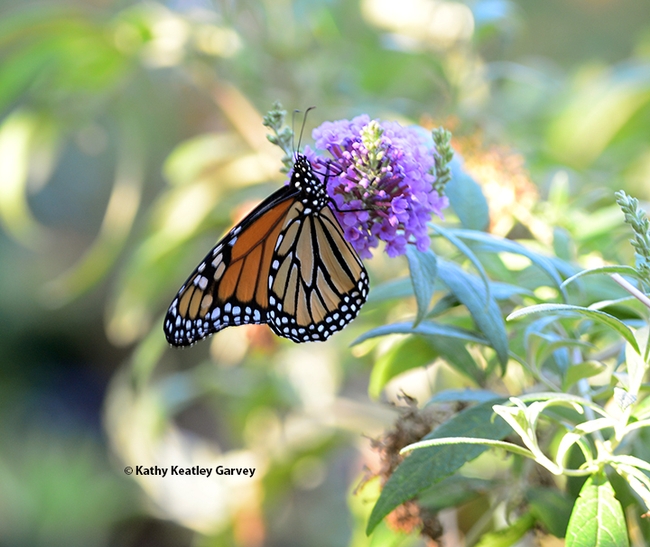
- Author: Kathy Keatley Garvey
Have are you faring during the COVID-19 crisis?
If you have a pollinator garden--or access to you--and a camera, you can step out of The Great Indoors and enjoy The Great Outdoors.
A newly eclosed Western Tiger Swallowtail, Papilio rutulus, however, can take your breath away.
This one recently visited our butterfly bush, Buddleia davidii, in our pollinator garden. It fluttered across the garden and headed straight toward one bush: the aptly named butterfly bush.
Wikipedia tells us: "The genus is found in four continents. Over 60 species are native through the New World from the southern United States south to Chile, while many other species are found in the Old World, in Africa, and parts of Asia, but all are absent as natives from Europe and Australasia. The species are divided into three groups based on their floral type: those in the New World are mostly dioecious (occasionally hermaphrodite or trioecious), while those in the Old World are exclusively hermaphrodite with perfect flowers."
There's a movement afoot NOT to plant Buddleia davidii (see the North American Butterfly Association's "The Great Butterfly Bush Debate"), but we've had ours for a decade, we keep it under control, and we love it for its beauty, its aroma, and its ability to draw a wide variety of insects.
Insects love it, too.
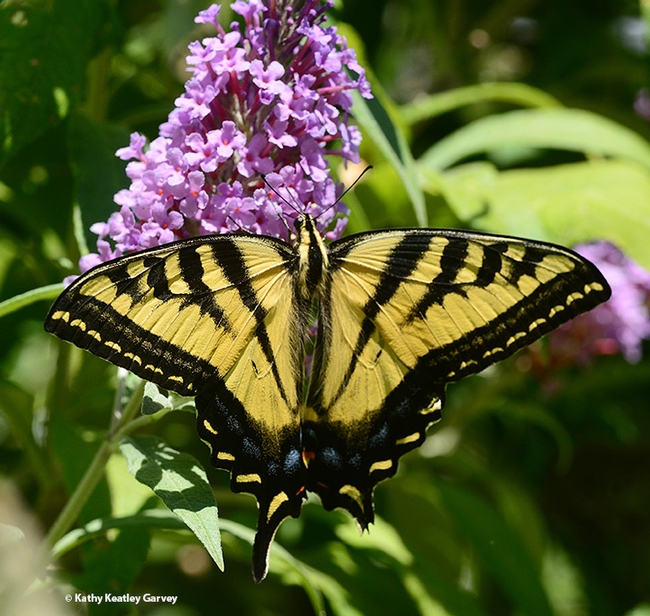
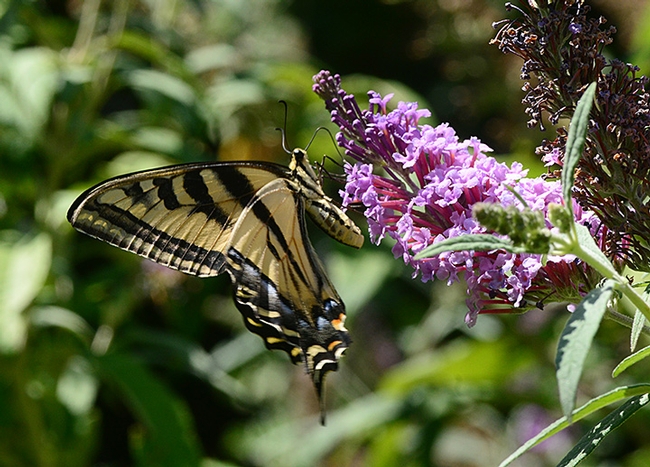
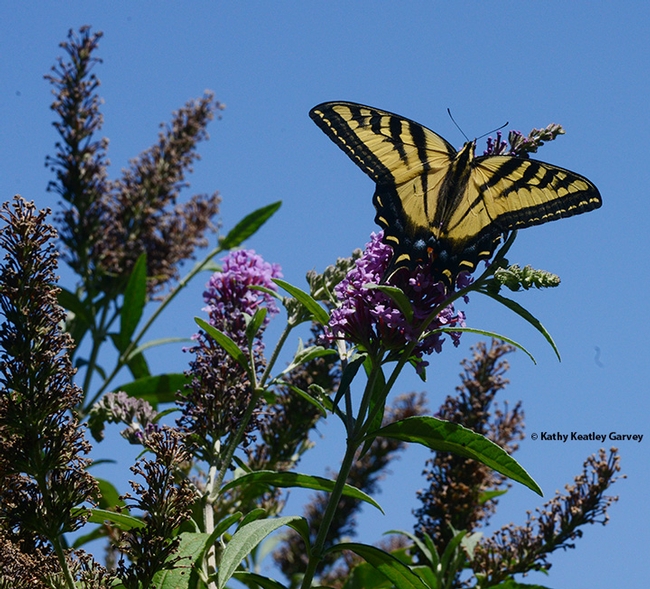
- Author: Kathy Keatley Garvey
It's Thanksgiving Day, and what better day to stop and be thankful for not only family and friends, but for the beauty around us.
That would include insects, including the stunning Western tiger swallowtail (Papilio rutulus).
Last summer we enjoyed watching a very gravid female, with a three-to-four-inch wingspan, nectaring on a butterfly bush (Buddleia davidii) in our Vacaville pollinator garden.
She also nectared on Verbena before departing--probably to lay her eggs on a nearby host plant, liquidambar (sweet gum) or a sycamore.
For just a few minutes, the Western tiger swallowtail graced our pollinator garden with her breathtaking beauty. We are thankful for her presence, and the presence of all the pollinators, past, present and future, in our little pollinator garden.
"Without the actions of pollinators, agricultural economies, our food supply, and surrounding landscapes would collapse," points out the Pollinator Partnership. "Birds, bats, bees, butterflies, beetles, and other small mammals that pollinate plants are responsible for bringing us one out of every three bites of food."
Happy Thanksgiving!
